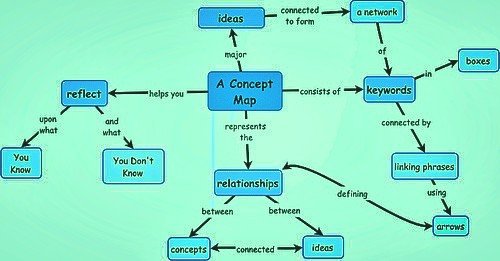Concept Map
A concept map is a diagram or graphical tool used to help students organise and represent knowledge of a subject. The broadest and comprehensive concepts are situated at the top of a concept map and the specific and exclusive concepts orchestrated hierarchically below. As such, a concept map is delineated to read from top to bottom.

Concept Map
Advantages of Concept Mapping
Idea mapping offers benefits for any learning procedure:
- Encourages understanding with its visual organization
- Combines data by incorporating new and old idea, so to better grasp the comprehensive picture
- Encourages brainstorming and higher order thinking.
- Map out connections between things, for example, vocab words, characters in a story, events in history and so forth.
- Cultivates discovery of new concepts and their associations
- Makes easy to understand the complex concepts
- take notes and make study guides
- Engrossing knowledge while studying for an exam
- Evaluating a student’s grasp of a specific topic
- Flashes creativity
- Previews your present learning to evaluate understanding
- Consolidating knowledge during the learning process
- Recognizes areas that require further learning or survey or review
Concept mapping can be a powerful tool in the world of education, helping students to perform at higher cognitive standards and helping teachers to clarify difficult subjects and review students’ understanding. The learners can utilize concept mapping to sort out and structure new material, enhance learning by relating new and old information, delineate connections between things, for example, vocab words, characters in a story, occasions in history and so forth, Plan/layout writing projects, plan their very own portrayals of knowledge, brainstorm new ideas, take notes, make study guides, plan complex structures.
Step by Step Instructions to Build a Concept Map
Concept maps are ordinarily hierarchical, with the subordinate ideas originating from the primary idea or concept. This sort of graphics organiser, in any case, enables change and new ideas to be added. The Rubber Sheet Analogy expresses that idea positions on a map can consistently change, while continually keeping up the same association with alternate ideas on the map.
Begin with a principle idea, topic, or issue to concentrate on.
A helpful way to decide the setting of your concept map is to pick a central question—something that should be tackled or a conclusion that should be reached. When a subject or question is chosen, it will help with the hierarchical structure of the concept map.

